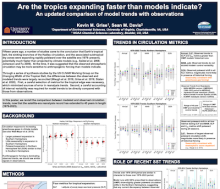Are the tropics expanding faster than models indicate? An updated comparison of model trends with observations
Kevin
Grise
University of Virginia
Poster
Over a decade ago, a number of studies came to the conclusion that Earth’s tropical belt, the sinking branches of the Hadley circulation, and the associated subtropical dry zones were expanding rapidly poleward, potentially much faster than most climate models indicated. At the time, it was suggested that the observed atmospheric circulation may be more sensitive to anthropogenic forcing than models indicate. However, through a series of synthesis studies by the US CLIVAR Working Group on the Changing Width of the Tropical Belt, the differences between the observed and modeled trends were largely reconciled. First, a careful selection of metrics for the tropical edge was necessary, which minimized sources of error in reanalysis trends. Second, a careful accounting of internal variability was required for model trends to be directly compared with those from observations.
In this presentation, we will summarize lessons learned from this model-observational intercomparison effort, many of which can be generalized to the evaluation of climate trends other than tropical expansion. Additionally, since most earlier studies only examined tropical expansion trends over the 1979-2008 period, we will extend our previous analyses through the early 2020s to verify if our key conclusions still hold or if, with a longer data record, the observed trends in the width of Earth’s tropical belt are becoming statistically distinct from the model trends. To do this, we will examine the latest reanalyses, such as ERA5 and MERRA-2, and climate model output, including CMIP6 models and potentially (if available by the time of the workshop) new AMIP runs extended to 2021 as part of the CERESMIP project.
In this presentation, we will summarize lessons learned from this model-observational intercomparison effort, many of which can be generalized to the evaluation of climate trends other than tropical expansion. Additionally, since most earlier studies only examined tropical expansion trends over the 1979-2008 period, we will extend our previous analyses through the early 2020s to verify if our key conclusions still hold or if, with a longer data record, the observed trends in the width of Earth’s tropical belt are becoming statistically distinct from the model trends. To do this, we will examine the latest reanalyses, such as ERA5 and MERRA-2, and climate model output, including CMIP6 models and potentially (if available by the time of the workshop) new AMIP runs extended to 2021 as part of the CERESMIP project.

Poster file
grise-kevin-confronting-poster.pdf
(5.05 MB)
Presentation file
grise-kevin-confronting-poster.pdf
(5.05 MB)
